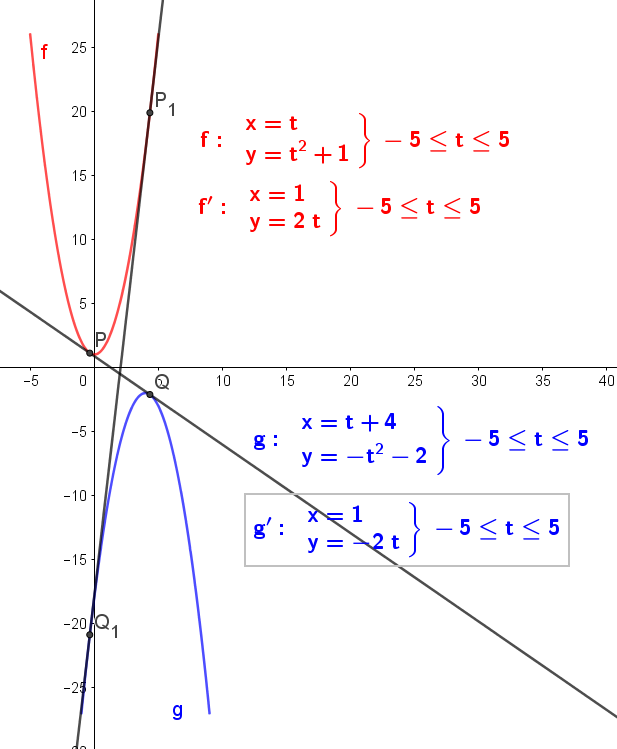Tangents Between Parabolas

Suppose we have two parabolas in the same plane and we want to get the lines that are tangent to both of them. We will work this problem by two methods to see which is easier.
Method 1) Use Cartesian equations to describe the tangent line(s) for each parabola. Then set their slope and intercept equal to each other. For some point on $f$, with coordinates $\left(a,f(a)\right)$ the tangent line to parabola $f$ is $$y-f(a)=f^{\prime}(a)\left(x-a\right)$$ and for some point on $g$, with coordinates $\left(b,g(b)\right)$ the tangent line to parabola $g$ is $$y-g(b)=g^{\prime}(b)\left(x-b\right).$$ Let's algebraically rearrange these to be in slope intercept form. $$y=f^{\prime}(a)\cdot x-f^{\prime}(a)\cdot a+f(a)$$ $$y=g^{\prime}(b)\cdot x-g^{\prime}(b)\cdot b+g(b)$$ Now equate their slopes $$f^{\prime}(a)=g^{\prime}(b) \tag{1} \label{1}$$ and intercepts $$-f^{\prime}(a)\cdot a+f(a)=-g^{\prime}(b)\cdot b+g(b). \tag{2} \label{2}$$ Next make the definitions from our equations, shown in the caption of figure 1. $$f(a)=a^{2}+1\qquad f^{\prime}(a)=2a$$ $$g(b)=-b^{2}+8b-18\qquad g^{\prime}(b)=-2b+8$$ Now make substitutions into $\eqref{1}$ and $\eqref{2}$. $$2a=-2b+8 \tag{3} \label{3}$$ $$-2a\cdot a+a^{2}+1=-(-2b+8)\cdot b+(-b^{2}+8b-18) \tag{4} \label{4}$$ Solve $\eqref{3}$ and $\eqref{4}$ simultaneously for $a$ and $b$. $$\left(\begin{array}{cc} a_{1} & b_{1}\\ a_{2} & b_{2} \end{array}\right)=\left(\begin{array}{cc} \frac{\sqrt{22}+4}{2} & \frac{-\sqrt{22}+4}{2}\\ \frac{-\sqrt{22}+4}{2} & \frac{\sqrt{22}+4}{2} \end{array}\right) \tag{4.5} \label{4.5}$$ At first it seems that somthing funny is going on with these solutions. It doesn't really look like they are different enough to describe two different tangent points on the two curves. However, we need to recall how these points are defined as $(a,f(a))$ and $(b,g(b))$. When these combinations are assembled, we do in fact get four distinct points. The lines between them are the tangent lines.
Method 2) Use vector (parametric) equations to describe the parabolas. Equate their slopes and their $x\text{-axis}$ intercept. The tangent line for function $f$ is written as $$\left(\begin{array}{c} x\\ y \end{array}\right)=f(r)+t\cdot f^{\prime}(r).$$ Variable $r$ represents some specific $t$ value which is sought. The function slope is $f^{\prime}(r)$. We will get its $x\text{-axis}$ intercept. To find that intercept, let $$\left(\begin{array}{c} x\\ 0 \end{array}\right)=\left(\begin{array}{c} x(f(r))\\ y(f(r)) \end{array}\right)+t\left(\begin{array}{c} x(f'(r))\\ y(f'(r)) \end{array}\right) \tag{5} \label{5}$$ Solve the top and bottom of $\eqref{5}$ for $t$ and equate them. $$\frac{x-x(f(r))}{x(f^{\prime}(r))}=t=\frac{0-y(f(r))}{y(f^{\prime}(r))} \tag{6} \label{6}$$ Then solve $\eqref{6}$ for $x$. The $x$-intercept is $(x,0)$. $$x=\frac{-y(f(r))\cdot x(f^{\prime}(r))}{y(f^{\prime}(r))}+x(f(r))$$ Repeat equations $\eqref{5}$ and $\eqref{6}$ for $g(s)$. Then equate the $f$ and $g$ $x$-intercepts. Finally, substitute in equation values from the problem for the terms. $$f(r)=\left(\begin{array}{c} r\\ r^{2}+1 \end{array}\right)\qquad f^{\prime}(r)=\left(\begin{array}{c} 1\\ 2r \end{array}\right)$$ $$g(s)=\left(\begin{array}{c} s+4\\ -s^{2}-2 \end{array}\right)\qquad g^{\prime}(s)=\left(\begin{array}{c} 1\\ -2s \end{array}\right).$$ The slope equation: $$2r=-2s. \tag{7} \label{7}$$ The $x$-axis intercept equation: $$\frac{-(r^{2}+1)\cdot1}{2r}+r=\frac{-(-s^{2}-2)\cdot1}{-2s}+s+4 \tag{8} \label{8}$$ Solve $\eqref{7}$ and $\eqref{8}$ simultaneously to get $$\left(\begin{array}{cc} r_{1} & s_{1}\\ r_{2} & s_{2} \end{array}\right)=\left(\begin{array}{cc} \frac{\sqrt{22}+4}{2} & \frac{-\sqrt{22}+4}{2}\\ \frac{-\sqrt{22}+4}{2} & \frac{\sqrt{22}+4}{2} \end{array}\right)$$ and compare to $\eqref{4.5}$.